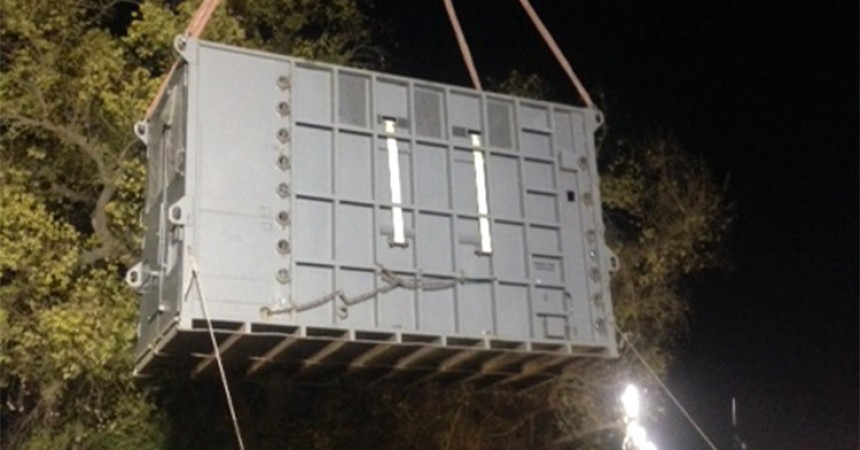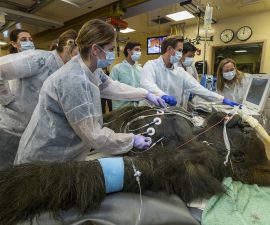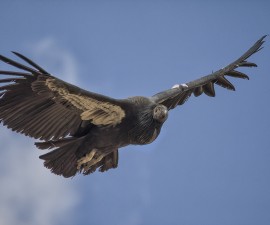Vus’musi, the first-born calf of the Safari Park’s herd, recently moved to the Fresno Chaffee Zoo. Affectionately known as “Moose” or “’Musi,” he holds a special place in the hearts of many members, blog readers, and Elephant Cam viewers, so we wanted to share the inside story of his “big adventure.” If you missed it before, you can still read Part 1, here.
There’s a lot of planning that goes into relocating a much beloved, 7,500-pound African elephant: paperwork, legal permits, contracts, travel routes, pit stops, escorts, pre-ship physicals, and the list goes on and on. From a training perspective, a successful move requires a lot of desensitization training, planning, and the ability to switch focus or adapt, along with precise timing. We put all these, and more, into getting Vus’Musi ready for his big adventure.
Originally, we thought we would move ‘Musi near the end of September, giving us plenty of time to desensitize him to the actual elephant crate and some of the approximations of placing heavy rear metal bars behind him to secure him inside. The move date was eventually set for an August evening, and ‘Musi was ready. For temperature concerns, an evening move made a lot of sense, as it was still summer. Our route also took heavy traffic out of the picture. For ‘Musi’s comfort, a swamp cooler was attached to one of the forward vents of the transport unit, just in case we felt he needed to be cooled off.
As we began to prepare, we had a quite a few things going for us; ‘Musi was one of our best trained elephants, we had experience with crate training elephants, and we had enough keepers with great relationships with him to pull it off. We decided that four of us (Mindy, Keith, Dion, and I) would be involved with the main training of the front leg tethers (Karissa also helped out on certain days). On the other hand, we also had some challenges. The timing of the move wasn’t very far removed from his last major tusk procedure, in which he was fully leg tethered and eventually darted on his rear end with an anesthetic tranquilizer (and yes—they do have great memory). After having had many tusk procedures, ‘Musi is very wary of anyone behind him, especially if it’s someone he doesn’t know.
Training moved along rather smoothly—so much so, that we started to desensitize him to “activity” behind him while his front legs were tethered to the crate. Unfortunately, ‘Musi spooked himself when his tail brushed along the crate; he reacted like he had just been darted again (at least that’s what it looked like to the keepers). It was at that point that ‘Musi realized that he was actually secured to the crate. The ordeal was a major setback and we were two weeks out from the big day. We had to switch focus quickly and make every session count. Our revised plan was to make the leg tethers and anklets a fun and highly reinforced “put-on and take-off game.” In a nutshell, we put anklets on both ankles at the west main gate, then sent him into the west holding yards and then into the west barn where we removed the anklets. At first, we removed them anywhere in the barn, but eventually we did this inside the crate that was located outside of the last barn stall.
We knew we wanted to have both front legs tethered for the move and we knew that he would notice that he had a length of leg tether (with its weight and sound) attached to his first leg, when we needed to ask for his other leg to tether to the crate. So while we continued with the “game,” we approximated and simulated the sound and weight of a leg tether. First, we attached a small length of tether to his first anklet, and when we asked him to drop his first leg to the ground to give us his other leg, we would drop a heavy, unattached tether onto the ground right next to his foot to simulate the sound of an attached tether. We also knew that we couldn’t afford another setback, so all approximations were done with ‘Musi not tethered to the crate—that would only happen on the actual day of the move.
Meanwhile, my staff and I had several meetings to practice the rest of the procedures for securing him into the crate (while he was nowhere around, of course). We also went over all the different scenarios that could take place during the move, along with input from our accompanying veterinarian, as well as the owner of the moving vehicle. All this preparation set the stage for the big day.
To make a long story short, ‘Musi was about as perfect as we could expect—and so was the entire move! We left the Safari Park with ‘Musi at 7 p.m. Wednesday night and arrived at Fresno Chaffee Zoo at 4:20 a.m. Thursday morning—just over nine hours of total travel time. Mindy and I accompanied him for the trip, and our familiar voices at the four pit stops we made probably reassured him that he wasn’t completely “alone” in this new adventure. I’m sure the watermelon, beet pulp, and choice browse that we gave him during those stops helped, too! Throughout the trip, ‘Musi was under constant, remote video surveillance by our vet, who was in a separate vehicle behind the truck. There were three chase vehicles in all, in addition to a CHP escort for half the trip up.
In a situation like this, experience is invaluable. Having the crate available ahead of time to approximate the behaviors needed is a must-have. Thanks again to Stephen Fritz and his crew for another successful move. His experience and expertise, along with his continuing innovation to improve the travel crates and their creature comforts, make for a pleasing experience throughout the process. Fritz helped us move our five Asian elephants to our Zoo in downtown San Diego, our five African elephants to Tucson, Msholo here from Orlando, Florida, and now Vus’musi to Fresno (and that’s just with the current herd here at the Safari Park!)
Jim Oosterhuis, San Diego Zoo Global veterinarian, has accompanied all of our elephant moves, and he’d be the first to tell you that he was happy that he didn’t have to do anything medically with ‘Musi because everything went smoothly! The keepers at the Safari Park did a fantastic job preparing for and then implementing the move safely and efficiently. Having the Fresno Chaffee Zoo staff waiting for his arrival and dealing with the unloading and cleaning of the crate so that Mindy and I could focus on ‘Musi, was something we both immensely appreciated in the wee morning hours of an all-nighter. But more about that—and how ‘Musi is doing—next time.
Curtis is the elephant supervisor at the San Diego Zoo Safari Park. Read his previous blog, Vus’musi’s Big Adventure, Part 1.






